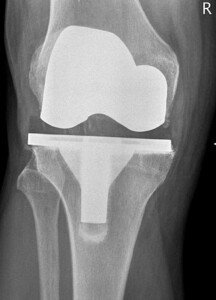
Here’s 12 things you’ll need around the house once you return home after a total knee replacement surgery.
These items should be purchased beforehand.
Even the most prepared-thinking person may not consider the usefulness of some of these items.
My father has had three total knee replacements (one a revision surgery), so I definitely know all the things that should already be in the home, once the patient returns.
The new knee will not be able to bend well. Hopping and balancing on the good leg is not an option because:
1) If a person’s knee was bad enough to require knee replacement surgery, the odds are pretty strong that the other knee is also degenerated.
2) Even if the other leg IS good enough to hop on, this is not advised because it will interfere with recovery.
The person must use both legs as he normally would, so that the new knee is properly introduced to normal movement.
12 Household Items You Need After Knee Replacement Surgery
1 Walker and a 4-pronged cane
2 Comfortable gloves to wear while using the walker, since palm pressure on the device can irritate bare skin.
3 Toilet seat extension
Because the knee can’t bend much, the patient won’t be able to sink down far enough to sit on a regular toilet seat.
Furthermore, the deep position will make it impossible or difficult for the person to get back up into his walker (which he will be needing to move even a few feet).
4 Sturdy seat with handles on either side, that must be at least 20 inches off the floor
This seat should be in the bathroom to allow the patient to sit and do things such as remove/put on shoes/slippers, remove/put on socks (and surgical stockings), remove/put on clothes, and sit while showering.
A similar seat should be in the bedroom. From this seat, the patient grips the handles and rises high enough to then grip the walker and steady himself.
5 A bell or whistle
The patient will often need unexpected assistance and will have to signal for help, and hollering is not always a viable option.
A whistle around the neck is also very useful for patients who don’t always remember to have their phone on them to summon someone, or whose elderly caretaker-spouse doesn’t use a mobile phone (many elderly people are not caught up with texting technology).
6 Suppositories, laxatives and an enema device
These may be necessary because the anti-blood-clotting drugs can cause constipation. So will inertia.
7 Portable urinal
The male patient may have uncontrollable urine leaking, due to catheterization at the hospital. So when the urge strikes, he can go in the handheld urinal, because by the time he shuffles to the nearest toilet, there may already be some leaking.
8 Adult diapers
For the patient who just might leak before getting to the toilet.
9 Food serving tray
The patient may want to spend a lot of time in the bedroom, so food will need to be taken to her.
10 Chair with arm rests
This is necessary for general lounging and when the patient does upper body exercises. The arm rests allow patient to get in and out of the chair. Ideally the chair should be higher than a standard chair, to minimize knee bending.
11 Shoes or slippers that have rubber soles
These will minimize slipping on non-carpeted flooring.
12 Iron supplement
The patient will have iron deficiency due to the surgery.
Additional Concerns
Make sure no rugs or mats might obstruct path of patient’s walker.
For the first several days upon the patient’s return home, a reasonably strong individual should be present to help lift the patient if he or she can’t stand up into the walker; and to guard against possible slipping while patient makes it up and down a staircase.
 Lorra Garrick is a former personal trainer certified by the American Council on Exercise. At Bally Total Fitness she trained clients of all ages for fat loss, muscle building, fitness and improved health.
Lorra Garrick is a former personal trainer certified by the American Council on Exercise. At Bally Total Fitness she trained clients of all ages for fat loss, muscle building, fitness and improved health.
.
























